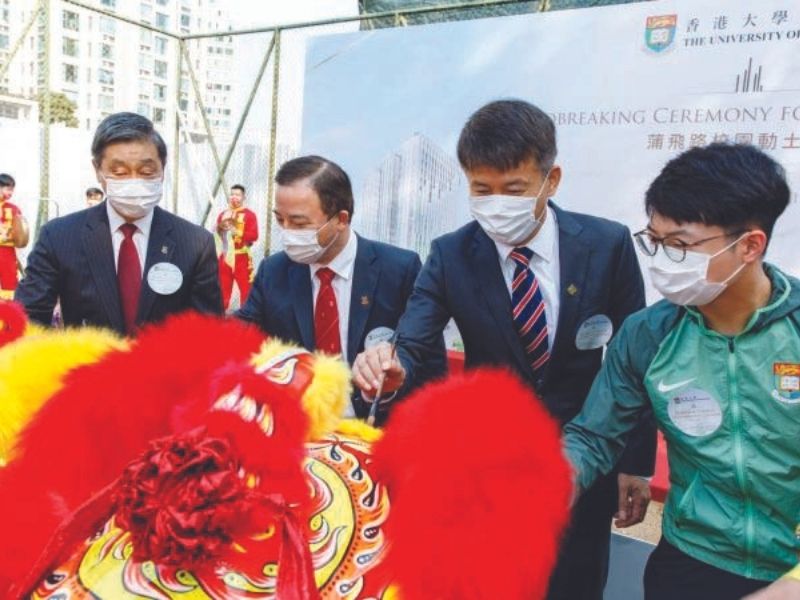
HKU new campus launch ceremony: rising government spending
In the sort of formal ceremony beloved in this part of the world, VIPs posed on stage, holding shovels decorated with giant gold bows, to mark the launch of a University of Hong Kong (HKU) campus redevelopment project.
The event held in January, could be viewed only online. However, the message was clear. Not even a pandemic is going to stop construction on a new home for the business school, sports facilities and residences. Over the next few years, HKU plans several other infrastructure projects and hundreds of new hires at the professorial level.
Hong Kong’s flagship institution is not alone in engaging in what seems like a spending spree. Similar developments are happening at universities across the more affluent parts of East and South-east Asia, where new institutes, departments and degree programmes are sprouting. Much of this recent rise in spending comes from state coffers, as well as from government messaging to business that education should be a target for philanthropy.
Mainland China’s higher education budget, for example, grew by 12 percent from 2019 to 2020. Meanwhile, companies with close state ties have responded to the siren call that they are expected to pitch in, especially in fields of study deemed politically or socially important. Vanke, a property conglomerate with links to the government, funded an eponymous public health school at Tsinghua University in spring 2020, right at the height of the country’s Covid outbreak.
Japan may not have the same annual budget increases as mainland China, but it too is making a concerted effort towards new financing. The government announced this year that it aims to raise capital for an eye-popping ¥10 trillion (Rs.6 lakh crore) university research fund by 2022. If it succeeds, it will have a fund double the size of Harvard University’s endowment.
Relatively smaller high-tech states are also trying to muscle in on the competition for top academics and students. Taiwan (pop.23 million) will spend an additional NT$83.6 billion (Rs.22,210 crore) over five years to develop universities, teaching and innovation, according to a 2019-20 report from the education ministry. The ‘Higher Education Sprout Project’ will also include incentives to offer “internationally competitive packages” for foreign academics, while Taiwan’s defence ministry will pitch into higher education institutions for the first time with an additional NT$5 billion programme for research. Growth is happening in developing nations, too. Malaysia, for example, has set aside an impressive 20 percent of its entire 2021 national budget for education.
There are also signs of development in other parts of Asia, even if they have been harder hit by Covid. India has ambitions to double the size of its higher education sector under its new National Education Policy 2020. Meanwhile, its latest budget, announced in February, included Rs.50,000 crore for the first five years of a new National Research Foundation (NRF). While state universities are struggling financially, private institutions have grown rapidly despite the Covid crisis. One case in point is O.P. Jindal Global University, which welcomed 209 new faculty in 2020 and an additional 112 this January.
Higher education systems in this part of the world are flourishing in part because they were spared much of the financial damage suffered by major English-speaking countries that have become reliant on income from international students. Institutions in the US, the UK and Australia, for instance, have seen drastic drops in revenue as Covid-19 kept overseas students away.
Asian institutions were never highly dependent on international fees to begin with, and they have continued to rely on high demand from local or regional students. They are also being bolstered by rising state support and growing local philanthropy, both of which are closely tied to notions of nation-building and social responsibility, especially since the Covid-19 pandemic.
Hugo Horta, an HKU associate professor studying the social contexts and policies of education, says Asian and Western higher education systems are “almost the opposite” in terms of their approach to financing. “In Western countries, like the US, the government became sidetracked away from funding universities, which are now almost completely reliant on the market. So to fund research, which is expensive, they need international students or donors. That’s not happening so much here,” he says.
Although social unrest that led to student arrests, police actions on campuses and a new national security law may have stirred up serious concerns about academic freedom in Hong Kong, it seems these factors, so far, have not had any negative effect on institutions’ academic performance or bank balances.
Moreover, it seems that the stereotype that new Asian money is going only to STEM and medical fields does not hold true. Hong Kong Baptist University’s philanthropic donations more than tripled from HK$81 million to HK$307 million (Rs.291 crore), partly because of its largest-ever gift for a new facility — the Jockey Club Campus of Creativity. Lingnan University, a liberal arts college, recorded an almost eightfold increase in donations, from HK$26 million to HK$204 million.
(Excerpted and adapted from Times Higher Education)
Also read: Hong Kong: Switch to US university model


























